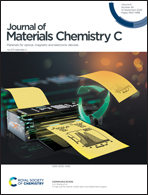Efficient bipolar AIE emitters for high-performance nondoped OLEDs†
Abstract
Three luminogens were designed and synthesized by integrating TPE with hole-transporting carbazole (Cz) and/or electron-transporting 1,2-diphenyl-1H-benzimidazole (PBi), and bare tetraphenylethene and another donor–acceptor (D–A) compound with aggregation-caused quenching (ACQ) were also prepared for comparison. In nondoped OLEDs, the best one with both aggregation-induced emission (AIE) properties and donor–acceptor (D–A) structures showed excellent performances with Lmax, CEmax, PEmax, and EQEmax of 24 308 cd m−2, and 15.10 cd A−1, 14.82 lm W−1, and 5.34%, respectively, which reached the theoretical limit of fluorescent OLEDs.



 Please wait while we load your content...
Please wait while we load your content...